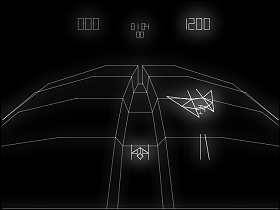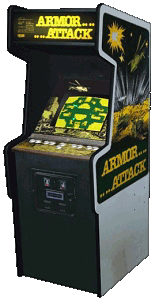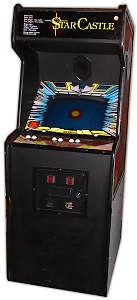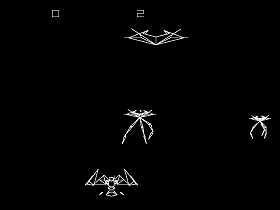Starhawk
 The Game: The player pilots a space fighter into an endless dogfight above a space station trench. Enemy ships attack from all directions, and even zip down the trench; and and all of these can be blasted into bits for points. Beware the fastest of these enemy fighters, which will appear with very little notice and fire directly at the player’s score, relieving it of points every time the fighter is successful with its attack! (Cinematronics, 1979)
The Game: The player pilots a space fighter into an endless dogfight above a space station trench. Enemy ships attack from all directions, and even zip down the trench; and and all of these can be blasted into bits for points. Beware the fastest of these enemy fighters, which will appear with very little notice and fire directly at the player’s score, relieving it of points every time the fighter is successful with its attack! (Cinematronics, 1979)
Memories: 1979 is the year that trench warfare – i.e. the Death Star trench – hit arcades and consoles alike. With the premiere of Star Wars in May 1977, game designers everywhere seemed to home in on the movie’s climactic flight through the Death Star trench as obvious video game material, and with good reason: the enclosed space offered plenty of hazards and limited room to maneuver, as well as the illusion of 3-D depth. As long as the hardware for a given project could handle the display requirements, the game play was a no-brainer – it had already been dictated by George Lucas and ILM. The only thing that kept the earliest variations on the Death Star trench theme from appearing immediately after the movie was the turnaround time for development, programming and manufacturing. [read more]

 The Game: Two armored knights coalesce out of thin air in an enclosed arena, swords at the ready. Before they can do battle, there’s the matter of simply navigating the arena’s geography: a pair of bottomless pits can lead either knight to his death, and each pit is surrounded on two sides by a staircase than can make for a handy resting place – or an even deadlier place to duel. There’s also a narrow catwalk between the pits. If the knights can stay on firm ground, the sword-swinging begins; when a knight is vanquished, he re-forms in the corner where he first appeared and can charge into battle again until he has lost all of his lives. Whoever’s still standing at the end of the game wins. (Cinematronics/Vectorbeam, 1979)
The Game: Two armored knights coalesce out of thin air in an enclosed arena, swords at the ready. Before they can do battle, there’s the matter of simply navigating the arena’s geography: a pair of bottomless pits can lead either knight to his death, and each pit is surrounded on two sides by a staircase than can make for a handy resting place – or an even deadlier place to duel. There’s also a narrow catwalk between the pits. If the knights can stay on firm ground, the sword-swinging begins; when a knight is vanquished, he re-forms in the corner where he first appeared and can charge into battle again until he has lost all of his lives. Whoever’s still standing at the end of the game wins. (Cinematronics/Vectorbeam, 1979) The Game: One or two players are at the controls of speedy ground assault vehicles which can zip around an enclosed maze of open areas and buildings with almost mouse-like speed. Heavy tanks and armed helicopters routinely appear in this maze, attempting to shoot any player vehicles they spot; the player(s) can, in turn, fire back at both of these vehicles. Caution: a damaged tank may still be able to draw a bead, so it’s best to keep firing until the tanks are completely destroyed. (Cinematronics, 1980)
The Game: One or two players are at the controls of speedy ground assault vehicles which can zip around an enclosed maze of open areas and buildings with almost mouse-like speed. Heavy tanks and armed helicopters routinely appear in this maze, attempting to shoot any player vehicles they spot; the player(s) can, in turn, fire back at both of these vehicles. Caution: a damaged tank may still be able to draw a bead, so it’s best to keep firing until the tanks are completely destroyed. (Cinematronics, 1980) The Game: You control a lone space fighter in the immediate vicinity of the nearly-impenetrable Star Castle. Its three layers of shields rotate, but those layers aren’t solid, so you might be able to get a shot in and destroy the alien craft at its center – but it’s also just as likely that the alien will get a clear shot at you…and its firepower is far greater. (Cinematronics, 1980)
The Game: You control a lone space fighter in the immediate vicinity of the nearly-impenetrable Star Castle. Its three layers of shields rotate, but those layers aren’t solid, so you might be able to get a shot in and destroy the alien craft at its center – but it’s also just as likely that the alien will get a clear shot at you…and its firepower is far greater. (Cinematronics, 1980) The Game: The Martians are coming! And they’re coming in colorful vector graphics! The tripod-like Martian War Machines land, extend their legs, and begin marching inexorably toward your cannon, pausing momentarily to sweep the bottom of the screen with their deadly heat rays, or hurling spirals of energy your way to slow down your cannon. You have a shield that can offer you mere moments of protection, but if it wears out or you find yourself in the Martians’ sights, your spiky-headed cannon operator is fried, and the cannon is promptly manned by another spiky-headed gunner. When your spiky-headed infantry is exhausted, the Martian invasion continues… (Cinematronics, 1981)
The Game: The Martians are coming! And they’re coming in colorful vector graphics! The tripod-like Martian War Machines land, extend their legs, and begin marching inexorably toward your cannon, pausing momentarily to sweep the bottom of the screen with their deadly heat rays, or hurling spirals of energy your way to slow down your cannon. You have a shield that can offer you mere moments of protection, but if it wears out or you find yourself in the Martians’ sights, your spiky-headed cannon operator is fried, and the cannon is promptly manned by another spiky-headed gunner. When your spiky-headed infantry is exhausted, the Martian invasion continues… (Cinematronics, 1981) The Game: In a bizarre combination of pinball, zero gravity, and nuclear physics, you pilot your “ship” around a reactor chamber, trying to eliminate rogue radioactive particles (which are about the same size as your ship). Anything touching the outer walls of the chamber will be destroyed, including your on-screen alter ego. Two pairs of five rods can be used to cool down the ever-expanding nuclear reaction at the center of the screen, but you can only push the rods in by bumping the particle into them head-on. Trapping particles in either of two cul-de-sacs in the upper right and lower left corners of the playing field will earn you bonus points, and the best way to accomplish this is to plant one of your limited number of decoys at the entrance to one of the smaller areas. In early levels, you can keep your back to the reactor and hug it as you bounce the particles off of it, but in later levels, the reactions are exposed and become just as deadly to you as to the walls are. (Gottlieb, 1982)
The Game: In a bizarre combination of pinball, zero gravity, and nuclear physics, you pilot your “ship” around a reactor chamber, trying to eliminate rogue radioactive particles (which are about the same size as your ship). Anything touching the outer walls of the chamber will be destroyed, including your on-screen alter ego. Two pairs of five rods can be used to cool down the ever-expanding nuclear reaction at the center of the screen, but you can only push the rods in by bumping the particle into them head-on. Trapping particles in either of two cul-de-sacs in the upper right and lower left corners of the playing field will earn you bonus points, and the best way to accomplish this is to plant one of your limited number of decoys at the entrance to one of the smaller areas. In early levels, you can keep your back to the reactor and hug it as you bounce the particles off of it, but in later levels, the reactions are exposed and become just as deadly to you as to the walls are. (Gottlieb, 1982)